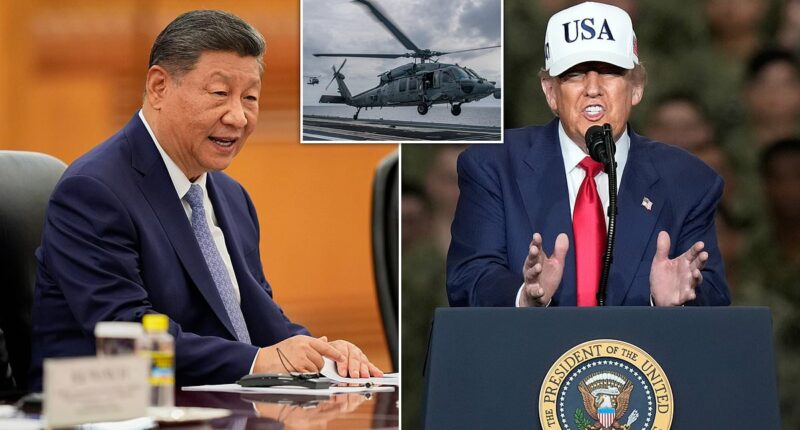Share this @internewscast.com
President Trump is preparing for one of the most anticipated meetings of his administration: a critical engagement with China’s Xi Jinping as he wraps up his tour of Asia.
Following the collapse of his outreach to Moscow and the implementation of new U.S. oil-trade sanctions against Russia, Trump is now focusing on Beijing. He aims to use the unsuccessful Russian dialogue as leverage to put pressure on Xi, who has been discreetly supporting Putin’s actions in Ukraine.
In a recent post on Truth Social, Trump openly criticized the Chinese leader, associating him with Putin and Kim Jong Un, while accusing Beijing of plotting ‘against the United States of America.’
However, whether Trump will maintain that assertive tone when meeting Xi in South Korea is uncertain.
Brent Sadler, a seasoned military diplomat in Asia with a 26-year Navy career, including his last post in the Pentagon’s China branch, cautions that Xi might not be willing to offer much to Trump.
“I doubt we’ll see anything new… They might agree to buy some soybeans, but that’s not a real concession. They need to change how they interact fundamentally. I just don’t see much room for concessions from the Chinese side,” Sadler, now a senior research fellow at the Heritage Foundation, shared with the Daily Mail.
Soybean purchases would offer a modest boost to US farmers and help trim the trade deficit, but they’re largely symbolic — a goodwill gesture that skirts the more serious disputes over technology and security.
Symbolically, Trump is arriving on a ‘wave of successes,’ Sadler notes, including renewed military and infrastructure partnerships with Japan and South Korea, two of China’s rivals.
A former Trump administration official told Daily Mail the president’s Asia swing has shifted the region’s balance of confidence.

President Donald Trump and Japanese Prime Minister Sanae Takaichi walk on the USS George Washington, an aircraft carrier docked at a U.S. naval base, before speaking to members of the military, in Yokosuka, Tokyo

In this photo provided by the North Korean government, Chinese President Xi Jinping, second right, and his wife Peng Liyuan greet North Korean leader Kim Jong Un, second left, and Russian President Vladimir Putin at the Forbidden City in Beijing in early September
‘The stakes are high, but the Chinese have more to lose,’ the official said.
Yet from Beijing’s view, limited gestures like buying soybeans or freeing a well–known Christian pastor, cost little but look generous on camera. Sadler calls them ‘contrived concessions,’ warning that Washington should not reward Beijing for ‘doing what it should have done in the first place.’
Instead, he says, reciprocity must be the rule: if China restricts American media, the US should treat Chinese outlets the same way; if Beijing blocks US industries, Washington should match the treatment.
According to the Wall Street Journal, Trump is even prepared to curtail the severity of his favorite weapon: tariffs.
That could easily mean that China nets the better deal, according to Brad Stetser, a Council on Foreign Relations senior fellow.
‘Bringing the Trump 2 tariff on China down to 20 percent (10 percent reciprocal, 10 percent fentanyl) is a huge win for China; it puts the new tariffs at the same level as the new tariffs on Southeast Asia,’ Setser said.
Behind the scenes, officials say there is already a framework for the Trump–Xi talks, developed under Treasury Secretary Scott Bessent.
‘We discussed a wide range of things from tariffs to trade, fentanyl, a substantial purchase of US agricultural products and rare earths,’ Bessent said.
The proposed framework includes further cooperation to curb the flow of fentanyl into the US, ‘substantial’ Chinese purchases of American soybeans, potential delays to export controls on rare–earth minerals and finalizing a deal to transfer TikTok ownership.
Trump himself, flying to Asia, underscored the uncertainty around each outcome outcomes, telling reporters on Air Force One, ‘what we understood yesterday or two days ago or even today is not going to be necessarily what it’s going to be in two days.’
The meeting’s real drama, Sadler suggests, will be about the optics.
He argues that Trump should make it publicly clear that Xi requested the summit.
In Asian diplomacy, Sadler explains, appearances are as important as actual agreements, and showing that China came to the table first would signal that ‘they’re in a weaker position.’

US President Donald Trump and Uzbekistan President Shavkat Mirziyoyev hold documents titled: ‘Economic Partnership between Uzbekistan and the United States: new horizons of cooperation’, showing the American technologies and equipment that Uzbekistan utilizes, as they meet during UNGA

Russia’s President Vladimir Putin walks with China’s President Xi Jinping and North Korea’s leader Kim Jong Un before a military parade marking the 80th anniversary of victory over Japan and the end of World War II, in Beijing’s Tiananmen Square

President Trump gestures as he prepares to alight from Air Force One upon arrival at Haneda Airport in Tokyo this week

President Trump gestures next to Japan’s Emperor Naruhito as he departs after their meeting at the Imperial Palace in Tokyo

President Trump greets Russia’s President Vladimir Putin on the tarmac at Joint Base Elmendorf-Richardson in Anchorage, Alaska. Trump cancelled their second summit this month
Trump’s own approach is expected to be guarded. Sadler notes that the former president ‘keeps his cards close’ in negotiations and has learned from experience not to trust easily after feeling betrayed by Xi during the early days of the Covid outbreak and blame–shifting.
That history, combined with the failure of his last attempt to deal directly with Putin, could set a tougher tone.
When Moscow tried to lure him into what Sadler calls ‘a familiar game,’ Trump simply walked away, and Sadler expects he would do the same with Xi rather than accept a shallow deal.
When assessing Trump’s diplomatic strategy, John Sitilides, national security senior fellow at the Foreign Policy Research Institute, notes a key difference between his dealings with Xi and Putin.
‘Trump’s menu of incentives and constraints differs between Xi and Putin. Xi needs a deal with Trump more than Putin needs to end his invasion of Ukraine. Putin believes the Russian economy can endure sanctions and that he can outlast Ukraine’s exhausted military and depleted arsenal.’
Behind the scenes, a former senior administration official says new energy–trade restrictions on Russia could be used to pressure Beijing. China’s financial system and industrial exports have kept Moscow afloat, and Asia experts note Xi values access to Western markets far more than friendship with the Kremlin.
For Sadler, that calculation is central: if China wants to preserve its economic future, it must distance itself from Russia’s war.
‘The differences between Washington and Beijing are too vast to solve in one meeting,’ Sitilides says. ‘A modest truce—ending Chinese fentanyl flows, reopening some trade, and committing to peace over Taiwan—could buy the US time to rebuild its defense and industrial strength.’
Whether the leaders achieve anything concrete may matter less than perception. If Trump and Xi simply sit down, Sadler says, that alone counts as a modest success. But if Trump walks away and calls out Beijing’s theatrics, it could mark the start of a harder era in US–China relations—and show that lessons from Moscow are now being applied in Beijing.





